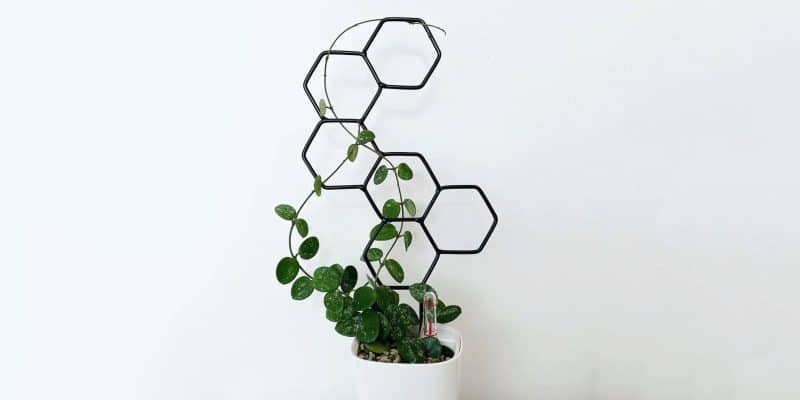With its dainty, heart-shaped leaves and fragrant, star-shaped flowers, Hoya Mathilde is sure to win your heart.
Hoya Mathilde is a captivating hybrid of two other popular Hoya species: Hoya carnosa and Hoya serpens. This delightful combo creates the perfect mix of attractive foliage and show-stopping blooms.
We’ll guide you through everything you need to know about Hoya Mathilde care so you can watch this beauty thrive in your home.
Table of Contents
Hoya Mathilde Plant Care Guide
History, Habitat, and Characteristics
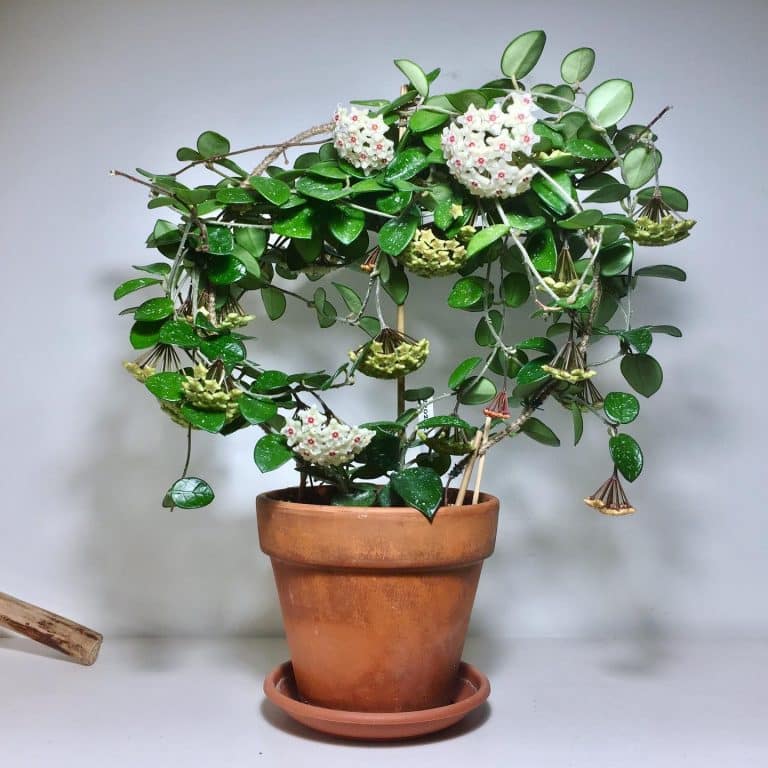
Hoya Mathilde (Hoya serpens x Hoya carnosa) is a delightful hybrid cultivar that will make any indoor garden come alive. The skilled horticulturist Emilio Begine brought this treasure to life in 1995, combining the best features of both parent plants.
The charming Hoya Mathilde plant wears its petite, round leaves with speckled silver, some of which are more splashy than others. They all have enchanting spider vein venations, which are especially noticeable when backlit.
When spring and summer roll around, white fuzzy flowers appear, boasting a pink corona that releases a sweet scent — but not everyone finds it appealing (kind of like cilantro).
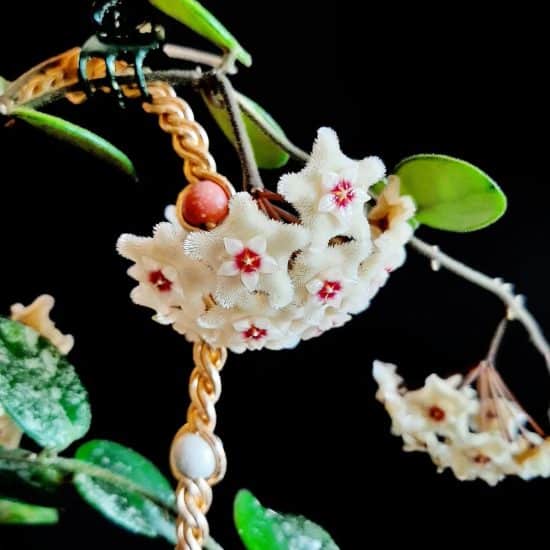
When it comes to this grand flowering debut, patience is key. The plant may take 2 to 3 years to produce blooms. But good things come to those who wait, right?
There’s a close cousin of Hoya Mathilde, the Hoya Mathilde ‘Splash’. It’s almost like looking in a mirror, except for some notable differences. The patchier silver speckling on the ‘Splash’ variety’s leaves covers a larger portion of the leaf. The ‘Splash’ also has a slight fuzz, which adds a touch of magic.
And if you’re looking for a high-splash hoya, the Hoya Mathilde ‘Splash’ is an affordable alternative to the high-maintenance ‘New Guinea Ghost’ or ‘Nova Ghost’.
Fun fact: Hoya Mathilde was named after the daughter of one of Emilio Begine’s friends, so this splendid plant is rooted in friendship!
Light
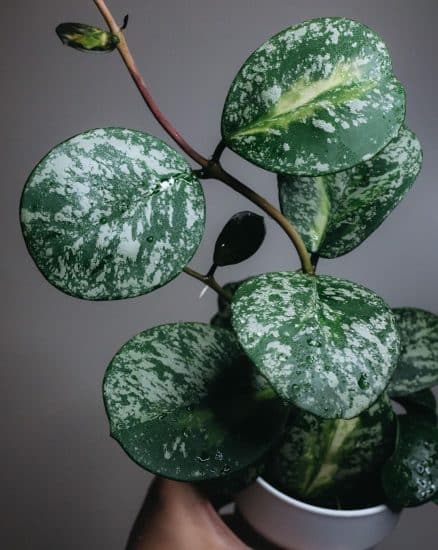
In their natural habitat, Hoya Mathilde bask in dappled light under the protection of trees. This plant will thrive indoors when we create these similar conditions, with a few adjustments.
Lots of indirect light is the secret to a happy Hoya Mathilde and other hoya plants. Placing it near an east-facing window, or a north one supplemented with grow lights, can help achieve that perfect balance. Since this plant doesn’t crave as much light as other hoyas, maintaining balanced lighting conditions will bring out the best in its dark green foliage and attractive splash pattern.
Be cautious of placing it near south-facing windows or too close to lights, as this excessive exposure can lead to dry, crispy leaves. If you start to notice this, it’s time to make an adjustment to its location.
Our lighting tips:
- Opt for an east or west-facing window to provide the ideal natural light.
- Complement with a grow light if unable to provide more sunlight, but be careful to avoid direct contact to protect the leaves.
- Monitor Hoya Mathilde’s foliage for signs of sun stress such as crispy leaves or diminished splash pattern.
Water
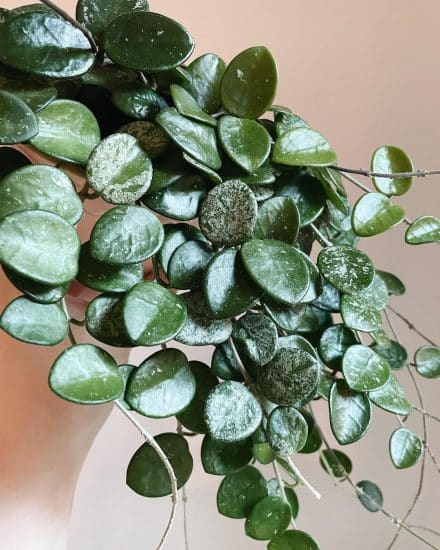
When it comes to watering frequency, it’s important to only water your Hoya Mathilde when the top layer of the soil feels dry to the touch. Provide thorough watering, but allow the soil to dry out completely before the next watering session.
If your Hoya Mathilde is not receiving enough water, plant leaves might begin to wilt and appear stressed, and growth could slow down or stop altogether. Since older leaves are thicker, focus on the softer upper leaves to gauge moisture content. In this case, consider increasing the watering frequency while still being mindful of the soil’s moisture levels.
On the other hand, if the plant is receiving too much water, you may notice yellowing leaves or a waterlogged appearance. In more severe cases, root rot can develop — you’ll see mushy roots and a foul smell. To prevent overwatering, always be sure that the soil has dried out before watering.
Bear in mind that the watering routine for your Hoya Mathilde may fluctuate with the seasons. During warmer months, you might need to water more frequently, as the plant grows at a faster pace. Conversely, for slower growth in cooler months, decrease your watering frequency.
Temperature and Humidity
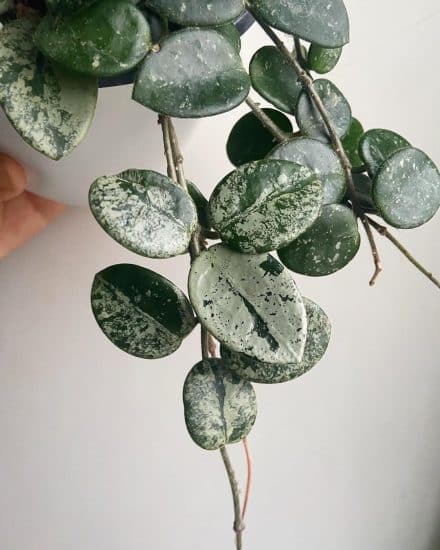
Providing the appropriate temperature and ideal humidity levels is essential for the well-being of your Hoya Mathilde.
For temperature, maintain a range between 65-80°F in the plant’s environment. This warmth-loving plant thrives both indoors on a windowsill and outdoors in a shaded spot. Although it prefers relatively higher temperatures, it easily adapts, making it a flexible plant in a variety of growing conditions.
Hoya Mathilde really prefers high humidity, around 80%, but can still survive at normal household levels, so no need to break out the terrarium or greenhouse. Watch for signs like wrinkles on the leaves or slowed growth, as they indicate insufficient humidity.
Soil and Planting
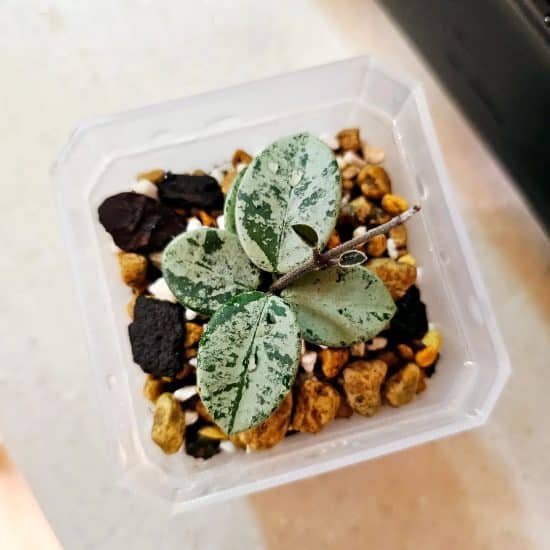
This versatile plant can be grown in pon, soil, or LECA, but we recommend using a soil mix containing perlite, orchid bark, and coconut husks for optimal results.
To create the right potting mix, use perlite to improve aeration and drainage. This ensures the roots get enough oxygen and helps prevent root rot. Add orchid bark for better air circulation and a loose structure for the roots to easily grow.
Finally, include coconut husks as an organic ingredient that helps retain moisture while allowing proper drainage, ensuring healthy development for your Hoya Mathilde.
When growing your plant in pon or LECA, you’ll need to make adjustments to your watering routine. Water less frequently for plants in pon, and keep the reservoir one-third full in LECA. A 3 or 3.5-inch container works well when using a soilless potting mix like one of these.
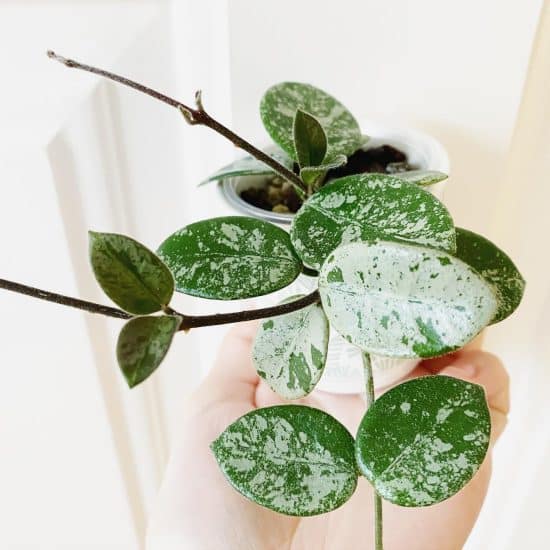
These plants prefer staying in a smaller pot for longer periods, up to 2 years. Consider repotting when the plant starts growing more prolifically. When repotting, always choose a slightly larger container with drainage holes and handle the roots gently.
When it’s growing in mediums other than soil, feeding your plant with liquid nutrients during every watering is essential. Consider using either general hydroponic nutrients or liquid dirt as a fertilizer.
To encourage blooming or peduncle growth, spray the plant with an orchid mix fertilizer like Miracle-Gro. Keep an eye out for signs of too much fertilizer, including yellowing leaves, slow growth, and a buildup of fertilizer residue on the soil surface.
If you suspect over-fertilization, flush the soil with water to remove excess nutrients and reduce the frequency and amount of fertilizer.
Propagation
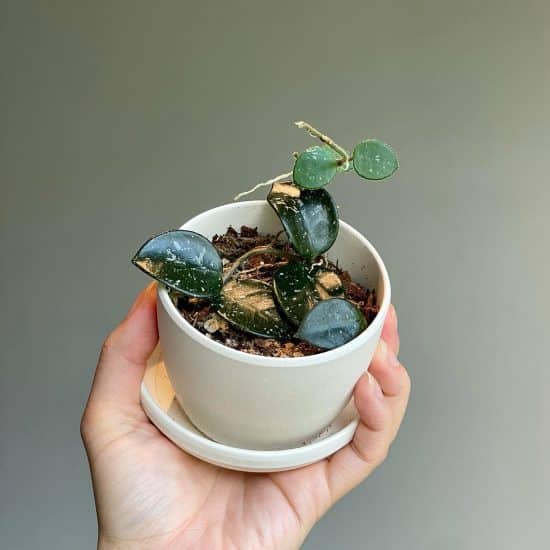
With Hoya Mathilde, you can try either soil or water propagation methods. When you cut the plant, the stem cuttings sprout another shoot from where they were cut, ensuring the mother plant keeps thriving.
Propagate Hoya Mathilde via stem cutting:
- Choose a healthy stem: Find a dangling stem with at least 3-4 leaves. Make sure it has a couple of nodes, which are the points where leaves emerge from the stem.
- Snip a 4-6 inch section: Grab your sterilized pruning shears or scissors, and cut a 4-6 inch part of the stem. Make the cut just below the node, making sure there are at least two nodes close to its base.
- Remove the lower leaves: Gently take off the bottom leaves of the cutting to expose the bottom node. This is the spot where the new roots will grow.
- Plant the cutting (soil propagation): Place the cut end of the stem into a well-draining potting mix, 1-2 inches deep. Keep the soil consistently moist without making it waterlogged. Place the cutting in a bright spot with indirect light.
- Place the cutting in water (water propagation): Submerge the cut end of the stem in a glass of water. Ensure the node is underwater, but the leaves remain above the waterline. Refresh the water every few days, and put the glass in bright indirect light.
- Observe: Over the next few weeks, pay close attention to your cutting’s progress. When root growth reaches about 1-2 inches in length, it’s time to move them to a permanent home.
- Transplant the cutting: Transfer your rooted cutting into a pot with a well-draining potting soil. Water it well and place it in bright indirect sunlight to encourage new growth. Maintain consistent moisture levels in the soil, and watch as your new Hoya Mathilde thrives.
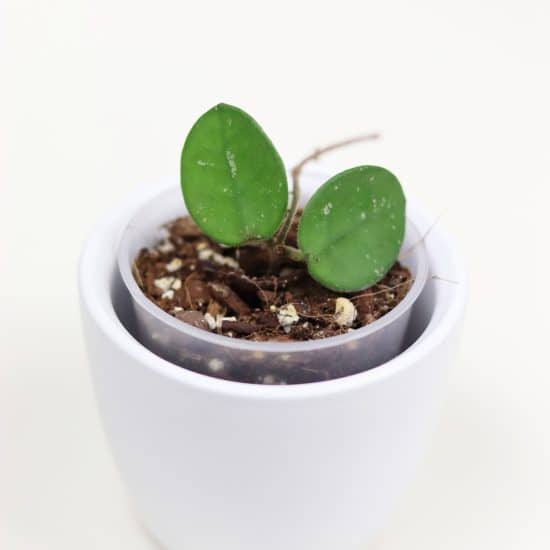
Our propagation tips:
- For best results, aim to propagate Hoya Mathilde during its active growing season, which is from spring to early summer.
- Always use clean, sterilized tools when taking cuttings to minimize the risk of fungal infections for the little hoya.
- For faster root development, cover the cutting with a clear plastic bag or container to keep humidity high while ensuring there’s still enough airflow to prevent mold and rot for the new plant.
Common Issues
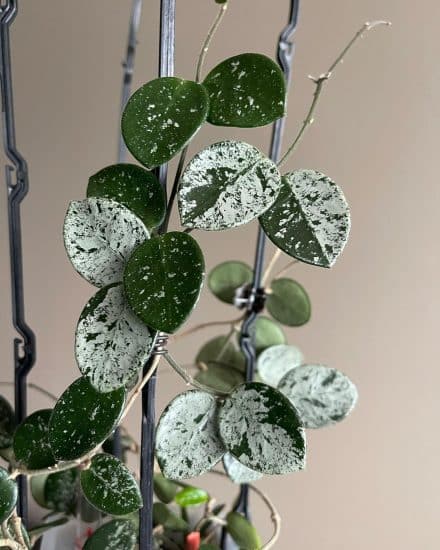
Although Hoya Mathilde is generally low-maintenance, there are a few common issues that may arise. Don’t worry, we’re here to help you diagnose and solve these problems.
Slow Growth
You may notice slow growth in your Hoya Mathilde, particularly during the first few months in its new environment. Assess your plant’s progress, specifically if it’s actively growing with new leaves and tendrils, or if they’re appearing at a significantly slower pace than expected.
To help your plant regain its vigor, ensure it receives an ample amount of indirect light and the right amount of moisture (see the “Light” and “Water” sections above). Additionally, provide a balanced, water-soluble fertilizer every 4-6 weeks during the growing season.
Dropping Leaves
It’s not unusual for Hoya Mathilde to occasionally lose leaves, and there can be several reasons behind this. If you observe leaves dropping, closely examine the plant, looking for any patterns or potential causes.
Tender and flimsy leaves typically indicate that the plant is thirsty and in need of water.
Dropping leaves can also be a sign that your plant needs more light — try to provide plentiful indirect light from a window with filtered sunlight or supplement its light needs using full-spectrum LED grow lights.
Finally, maintaining a consistent room temperature between 60-80°F (15-27°C) is crucial.
Pests and Diseases
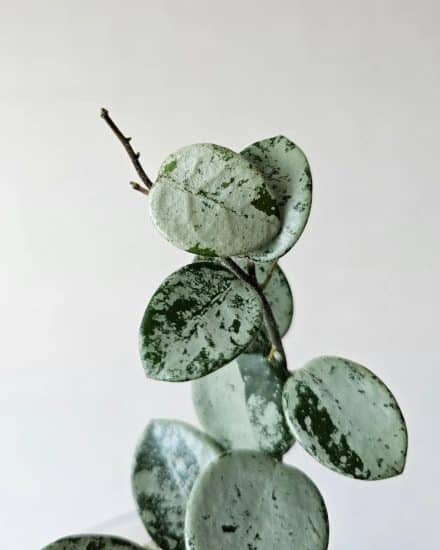
Root Rot
Root rot can sneak up on even the most attentive plant caretakers, due to overwatering or inefficient drainage. To keep this condition at bay for your Hoya Mathilde, be mindful about watering and make sure your plant sits in well-draining soil with drainage holes in its pot.
Root rot clues include yellow leaves, a strange smell, and roots that are black or mushy. To fix the problem, take your plant out of the pot, trim the damaged roots with a sterilized cutting tool, and repot it in fresh soil. From now on, water your plant only when the top inch of the soil dries out.
Pests
Your Hoya Mathilde might not suffer from many pest issues, but it’s still a good idea to watch out for uninvited houseplant guests like mealybugs, spider mites, and aphids. These tiny troublemakers can harm your plant and spread to your other houseplants.
Be proactive by inspecting your plant often for signs of pests: small bugs, webbing, or sticky residue on the leaves and stems.
If you spot pests on your Hoya Mathilde, give it some space from the rest of your plants to keep the issue from spreading. Start treating the problem by wiping the affected areas with a damp cloth.
For tougher infestations, you can use a diluted dish soap solution, neem oil, or insecticidal soap on the leaves and stems (don’t forget the underside of the leaves, too). Continue treating every few weeks until the pests are gone, and always stay vigilant for signs of another infestation.
Conclusion
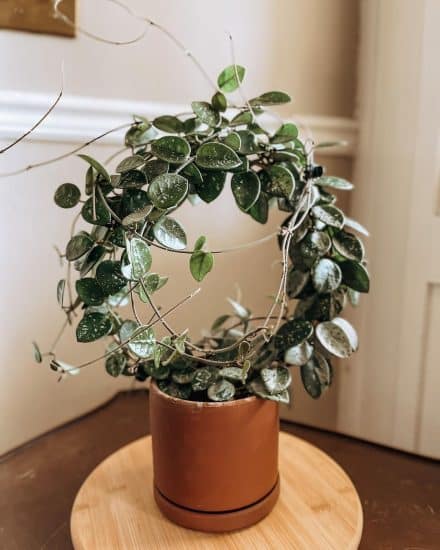
That’s a wrap for our Hoya Mathilde care guide!
This enchanting hybrid brings a blend of charm and resilience to your indoor garden. We hope your Hoya Mathilde will flourish, rewarding you with delightful foliage and fragrant blooms, and a great additional to your hoya collection.
Hoya Mathilde care summary:
- Provide bright, indirect light to keep its foliage vibrant and its growth steady. Avoid direct sunlight to prevent leaf burn.
- Water the plant when the top inch of soil feels dry, and be mindful of overwatering.
- Maintain a temperature range of 65-80°F and a higher humidity level of around 80% for optimal growth.
- Use a well-draining soil mix containing perlite, orchid bark, and coconut husks.
- Fertilize during the growth season with a balanced, water-soluble fertilizer or an orchid mix fertilizer to encourage new flowers.
- Propagate through stem cutting, using either soil or water propagation methods.
If you have any questions or concerns that we didn’t cover, feel free to connect with us. And if you found this guide to be valuable, consider sharing it with your fellow plant lovers!
Take care, and happy growing!
FAQ
Is Hoya Mathilde ‘Splash’ a different plant?
Hoya Mathilde ‘Splash’ is not a different plant — it’s actually a variation of the Hoya Mathilde. The term “splash” refers to the unique appearance of its foliage, which exhibits small white or silver flecks (splashes) on the green leaves.
These splashes add an attractive visual dimension to the plant, making it even more appealing for those looking to add a touch of beauty to their indoor or outdoor gardens.
What features does Hoya Mathilde get from Hoya carnosa and Hoya serpens?
From Hoya carnosa, Hoya Mathilde plants inherit their robust growth pattern and adaptability to different environments and growing conditions. Being able to adjust to your home’s humidity levels? Thanks, carnosa. This quality makes it an excellent choice for both indoor and outdoor gardening.
On the other hand, Hoya Mathilde takes after Hoya serpens in terms of foliage and flower characteristics, with smaller, rounded, and slightly succulent leaves.
The plant’s adorable, fragrant flowers are a combination of features from both parent plants. They exhibit the delicate, fuzzy appearance of a serpens blooms with the more substantial size and star-shaped form of carnosa flowers.

